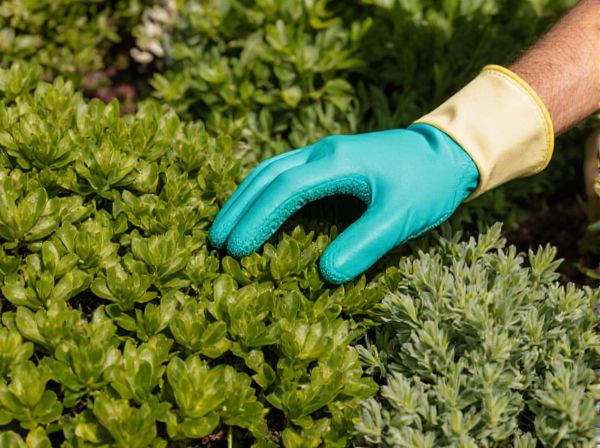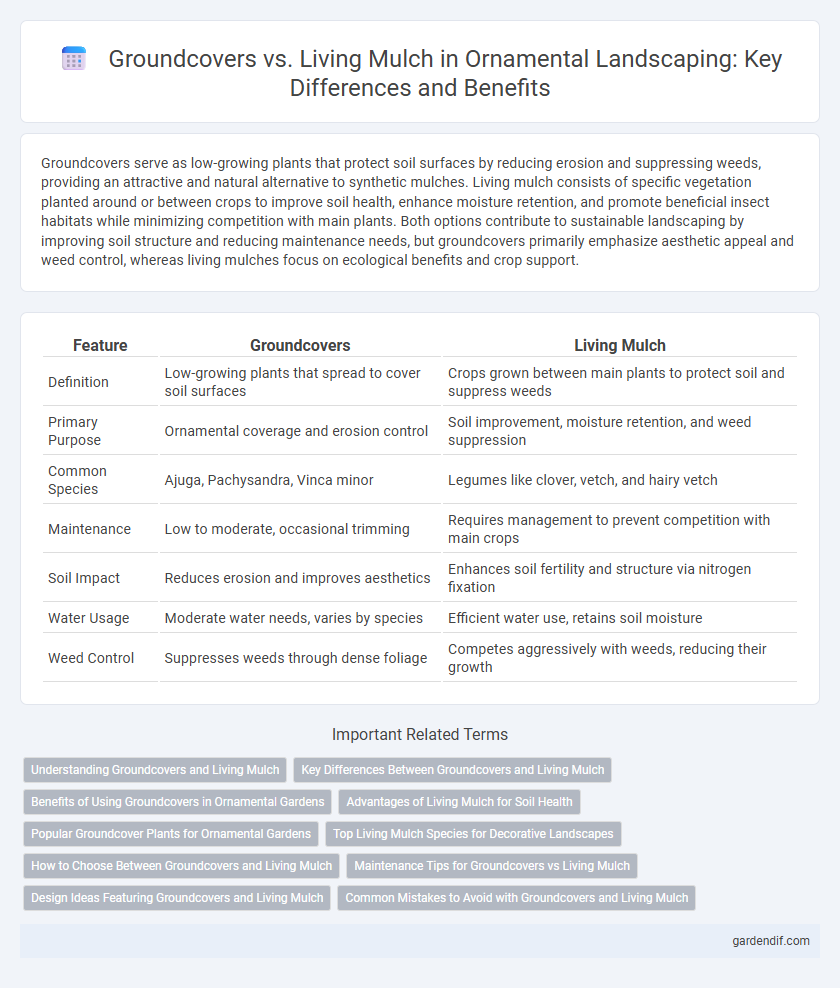
Groundcovers vs Living Mulch Illustration
Groundcovers serve as low-growing plants that protect soil surfaces by reducing erosion and suppressing weeds, providing an attractive and natural alternative to synthetic mulches. Living mulch consists of specific vegetation planted around or between crops to improve soil health, enhance moisture retention, and promote beneficial insect habitats while minimizing competition with main plants. Both options contribute to sustainable landscaping by improving soil structure and reducing maintenance needs, but groundcovers primarily emphasize aesthetic appeal and weed control, whereas living mulches focus on ecological benefits and crop support.
Table of Comparison
| Feature | Groundcovers | Living Mulch |
|---|---|---|
| Definition | Low-growing plants that spread to cover soil surfaces | Crops grown between main plants to protect soil and suppress weeds |
| Primary Purpose | Ornamental coverage and erosion control | Soil improvement, moisture retention, and weed suppression |
| Common Species | Ajuga, Pachysandra, Vinca minor | Legumes like clover, vetch, and hairy vetch |
| Maintenance | Low to moderate, occasional trimming | Requires management to prevent competition with main crops |
| Soil Impact | Reduces erosion and improves aesthetics | Enhances soil fertility and structure via nitrogen fixation |
| Water Usage | Moderate water needs, varies by species | Efficient water use, retains soil moisture |
| Weed Control | Suppresses weeds through dense foliage | Competes aggressively with weeds, reducing their growth |
Understanding Groundcovers and Living Mulch
Groundcovers are low-growing plants that spread rapidly to cover soil, preventing erosion and suppressing weeds while enhancing garden aesthetics. Living mulch refers to specific groundcovers planted densely alongside crops to improve soil health, conserve moisture, and reduce weed competition without affecting crop yields. Both groundcovers and living mulches play a vital role in sustainable landscaping by promoting biodiversity and maintaining soil structure.
Key Differences Between Groundcovers and Living Mulch
Groundcovers are low-growing plants primarily used for decorative purposes, soil erosion control, and weed suppression in ornamental landscapes. Living mulch involves planting companion species closely with main crops or plants, providing benefits like moisture retention and nutrient improvement without competing heavily for resources. Unlike groundcovers, living mulch is more functional in supporting plant health and productivity while integrating seamlessly into agricultural or garden systems.
Benefits of Using Groundcovers in Ornamental Gardens
Groundcovers enhance ornamental gardens by providing erosion control, moisture retention, and weed suppression, creating a healthy growing environment. Their dense foliage adds aesthetic value through varied textures and colors, reducing maintenance needs. Groundcovers also improve soil fertility and stability, supporting the longevity and vibrancy of ornamental plantings.
Advantages of Living Mulch for Soil Health
Living mulch enhances soil health by improving organic matter content and promoting beneficial microbial activity, which increases nutrient availability and soil structure. Its continuous cover reduces erosion and moisture evaporation, maintaining optimal soil hydration and temperature for plant roots. Unlike traditional groundcovers, living mulch actively contributes to nutrient cycling through nitrogen fixation and decomposing biomass, fostering long-term soil fertility.
Popular Groundcover Plants for Ornamental Gardens
Popular groundcover plants for ornamental gardens include creeping thyme, ajuga, and vinca minor, valued for their vibrant foliage and flowers that create visually appealing landscapes. These plants suppress weeds effectively while requiring minimal maintenance, enhancing garden aesthetics through year-round coverage. Their adaptability to various soil types and light conditions makes them ideal for enhancing garden texture and color contrast.
Top Living Mulch Species for Decorative Landscapes
Top living mulch species for decorative landscapes include creeping thyme, ajuga, and sedum, valued for their low maintenance and vibrant foliage. These groundcovers enhance soil moisture retention and suppress weeds while providing continuous seasonal color and texture. Selecting species like creeping thyme also attracts pollinators, contributing to a healthy and visually appealing garden ecosystem.
How to Choose Between Groundcovers and Living Mulch
Selecting between groundcovers and living mulch depends on specific garden needs such as erosion control, aesthetics, and weed suppression. Groundcovers often provide dense, decorative foliage ideal for enhancing landscape design, while living mulch focuses on improving soil health and moisture retention by growing around crop bases. Assessing site conditions, plant compatibility, and maintenance requirements helps determine the most effective option for sustainable garden management.
Maintenance Tips for Groundcovers vs Living Mulch
Groundcovers require regular pruning and occasional replanting to prevent overgrowth and maintain visual appeal, while living mulch needs consistent monitoring to avoid competition with primary plants for nutrients and water. Applying organic mulch around groundcovers helps retain soil moisture and suppress weeds, whereas living mulch benefits from balanced fertilization to support both the cover and main crops. Proper irrigation techniques, tailored to the moisture needs of each type, enhance durability and minimize maintenance effort in ornamental gardens.
Design Ideas Featuring Groundcovers and Living Mulch
Design ideas featuring groundcovers and living mulch enhance garden aesthetics by providing lush, low-maintenance surfaces that suppress weeds and retain soil moisture. Popular groundcovers like creeping thyme, sedum, and ajuga create vibrant color palettes and textures, while living mulch options such as clover and winter rye add nitrogen to the soil, promoting plant health. Combining diverse species in landscaping plans can optimize ground coverage, improve soil quality, and create visually appealing garden layers.
Common Mistakes to Avoid with Groundcovers and Living Mulch
Common mistakes with groundcovers and living mulch include improper plant selection that ignores local climate and soil conditions, leading to poor growth and invasive spread. Overcrowding plants reduces airflow and increases disease risk, while neglecting regular maintenance like weeding and trimming allows weeds to outcompete desired vegetation. Avoiding these errors ensures healthy groundcovers that effectively suppress weeds and maintain soil moisture.
Groundcovers vs Living Mulch Infographic

 gardendif.com
gardendif.com